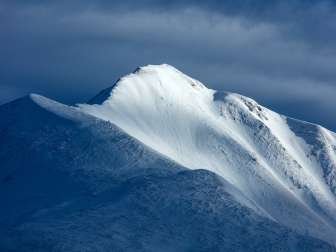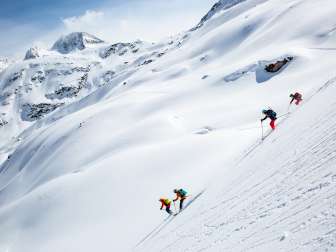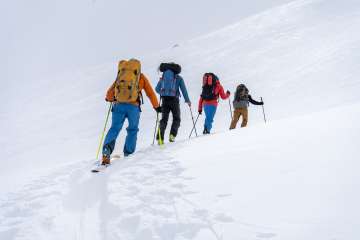Avalanches pose a great danger on tours away from the marked pistes. Tourers should be able to recognize and correctly assess the dangers. It is also important to know what to do in an emergency. Find out about the weather and snow conditions in the area beforehand. For non-experts, we recommend avalanche and ski touring courses under expert supervision or guided tours by mountain guides.
Current situation
In the avalanche bulletin of the Swiss Institute for Snow and Avalanche Research you will find all the data on the snow and avalanche situation in Switzerland.


The comprehensive portal for avalanche prevention
White Risk supports you in making your tours in the winter mountains as safe as possible. In preparation, on the move and during training.

Grischa Mountain Sports School
The Grischa Mountain Sports School offers avalanche and ski touring courses for beginners and advanced skiers alike. Leave nothing to chance and learn to read the snow.
Professional tips for assessing the avalanche danger
- Second snowfall: If fresh snow falls on top of the old snow cover after a long break in snowfall, poor bonding creates gaps that can be fatal for ski tourers.
- Slippery snow: Often occurs on steep slopes after the first snowfall. It can be recognized by the wide cracks in the snow cover.
- Rainfall: Water dissolves the binding of the snow, loads additional weight onto the snow cover, causing water channels to form. Consequence: The snow cover loosens. Rain is a clear warning sign to abandon a tour!
- Temperatures: If cold fresh snow meets warm old snow, dangerous layers of snow could form that could still be a hazard a few days later.
- Cold period: The cold causes so-called floating snow to form on the old snow. If fresh snow falls on this old snow, it becomes dangerous as the different types of snow hardly bind together.
- Wind: If it blows before or after the snowfall, dangerous formations can develop.
- Little snow: The risk of avalanches is lower when there is a lot of snow, as the snow can build up easily. Avoid places with little snow, such as mountain ridges.
- Steep slopes: Ride extremely steep slopes and key sections individually.
- Spring: The rise in temperature and the wetter climate can increase the risk of avalanches.
- Equipment: Always carry an avalanche transceiver with you, as well as a shovel and probe.
Liability
Ski and splitboard tours in open terrain are at your own risk. Liability claims of any kind against Viamala Tourismus and the authors are excluded. Climbing routes requires good physical condition, serious preparation and technical knowledge of mountain sports. For safe mountain sports, Viamala Tourism recommends training under expert supervision or guided tours by trained mountain guides.
